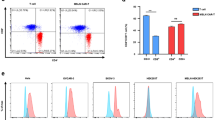Abstract
That specific immunotherapy can inhibit cancer growth has been recognized; its efficiency is to be improved. This study aimed to inhibit lung cancer (LC) growth in a mouse model by using an LC-specific vaccination. In this study, a LC mouse model was created by adoptive transplantation with LC cells. The tumor-bearing mice were vaccinated with LC cell extracts plus adjuvant TNBS or adoptive transplantation with specific CD8+ CD196+ T cells. The results showed that the vaccination with LC extracts (LCE)/TNBS markedly inhibited the LC growth and induced CD8+ CD196+ T cells in LC tissue and the spleen. These CD8+ CD196+ T cells proliferated and produce high levels of perforin upon exposure to LCE and specifically induced LC cell apoptosis. Exposure to TNBS induced RAW264.7 cells to produce macrophage inflammatory protein-3α; the latter activated signal transducer and activator of transcription 3 and further induced perforin expression in the CD8+ CD196+ T cells. Adoptive transfer with specific CD8+ CD196+ T cells suppressed LC growth in mice. In conclusion, immunization with LC extracts and TNBS can induce LC-specific CD8+ CD196+ T cells in LC-bearing mice and inhibit LC growth.






Similar content being viewed by others
References
Chen W, Zheng R, Zhang S, Zhao P, Li G, Wu L, He J. Report of incidence and mortality in China cancer registries, 2009. Chin J Cancer Res. 2013;25:10–21.
Siegel RND, Jemal A. Cancer statistics, 2013. CA Cancer J Clin. 2013;63:11–3.
Akhurst TMM, Hicks RJ. Lung cancer. PET Clin. 2015;10:147–58.
Holt GEPE, Raez LE. Immunotherapy as a strategy for the treatment of non-small-cell lung cancer. Therapy. 2011;8:43–54.
Feng BSCX, He SH, Zheng PY, Foster J, Xing Z, Bienenstock J, Yang PC. Disruption of T-cell immunoglobulin and mucin domain molecule (TIM)-1/TIM4 interaction as a therapeutic strategy in a dendritic cell-induced peanut allergy model. J Allergy Clin Immunol. 2008;122:55–61.
Yao X, Wang W, Li Y, Huang P, Zhang Q, Wang J, et al. IL-25 induces airways angiogenesis and expression of multiple angiogenic factors in a murine asthma model. Respir Res. 2015;16:39.
Dungan LS, McGuinness NC, Boon L, Lynch MA, Mills KH. Innate IFN-gamma promotes development of experimental autoimmune encephalomyelitis: a role for NK cells and M1 macrophages. Eur J Immunol. 2014;44:2903–17.
Kosaka A, Ohkuri T, Ikeura M, Kohanbash G, Okada H. Transgene-derived overexpression of miR-17-92 in CD8+ T-cells confers enhanced cytotoxic activity. Biochem Biophys Res Commun. 2015;458:549–54.
Wang BQZC, Gao W, Wang XF, Zhang HL, Yang PC. Cancer-derived matrix metalloproteinase-9 contributes to tumor tolerance. J Cancer Res Clin Oncol. 2011;137:1525–33.
Yu QLX, He Y. Preferential recruitment of Th17 cells to cervical cancer via CCR6-CCL20 pathway. PLoS ONE. 2015;10:e0120855.
Ferraccioli GZG. The potential role of Th17 in mediating the transition from acute to chronic autoimmune inflammation: rheumatoid arthritis as a model. Discov Med. 2011;11:413–24.
Annunziato FSV, Maggi L, Cosmi L, Liotta F, Romagnani S. Reasons for rarity of Th17 cells in inflammatory sites of human disorders. Semin Immunol. 2013;25:299–304.
Li X, Zhou Q, Yang WB, Xiong XZ, Du RH, Zhang JC. Pleural mesothelial cells promote expansion of IL-17—producing CD8+ T cells in tuberculous pleural effusion. J Clin Immunol. 2013;33:775–87.
Zou Y, Li WY, Wan Z, Zhao B, He ZW, Wu ZG, et al. Huangqin-Tang ameliorates TNBS-induced colitis by regulating effector and regulatory CD4(+) T cells. BioMed Res Int. 2015;2015:102021.
Kato K, Nomoto M, Izumi H, Ise T, Nakano S, Niho Y, et al. Structure and functional analysis of the human STAT3 gene promoter: alteration of chromatin structure as a possible mechanism for the upregulation in cisplatin-resistant cells. Biochim Biophys Acta. 2000;1493:91–100.
Elgueta R, Marks E, Nowak E, Menezes S, Benson M, Raman VS, et al. CCR6-dependent positioning of memory B cells is essential for their ability to mount a recall response to antigen. J Immunol. 2015;194:505–13.
Torres R, Serra-Pages M, Plaza J, Herrerias A, Costa-Farre C, Marco A, et al. Activation of the Prostaglandin E2 receptor EP2 prevents house dust mite-induced airway hyperresponsiveness and inflammation by restraining mast cells activity. Clin Exp Allergy. 2015;45:1590–600.
Robinson AM, Sakkal S, Park A, Jovanovska V, Payne N, Carbone SE, et al. Mesenchymal stem cells and conditioned medium avert enteric neuropathy and colon dysfunction in guinea pig TNBS-induced colitis. Am J Physiol Gastrointest Liver Physiol. 2014;307:G1115–29.
Katchar K, Kelly CP, Keates S, O’Brien MJ, Keates AC. MIP-3alpha neutralizing monoclonal antibody protects against TNBS-induced colonic injury and inflammation in mice. Am J Physiol Gastrointest Liver Physiol. 2007;292:G1263–71.
Lee SK, Pi SH, Kim SH, Min KS, Lee HJ, Chang HS, et al. Substance P regulates macrophage inflammatory protein 3alpha/chemokine C-C ligand 20 (CCL20) with heme oxygenase-1 in human periodontal ligament cells. Clin Exp Immunol. 2007;150:567–75.
Law RH, Lukoyanova N, Voskoboinik I, Caradoc-Davies TT, Baran K, Dunstone MA, et al. The structural basis for membrane binding and pore formation by lymphocyte perforin. Nature. 2010;468:447–51.
Author contributions
JZ, JL, HC, WW, XL, YW, ZW, KZ, YL, YW and HL performed experiments, analyzed data and reviewed the manuscript. LG designed the project, supervised the research and wrote the paper.
Author information
Authors and Affiliations
Corresponding author
Ethics declarations
Conflict of interest
None.
Additional information
Jian Zhang and Jing Liu are joint first authors.
Rights and permissions
About this article
Cite this article
Zhang, J., Liu, J., Chen, H. et al. Specific immunotherapy generates CD8+ CD196+ T cells to suppress lung cancer growth in mice. Immunol Res 64, 1033–1040 (2016). https://doi.org/10.1007/s12026-016-8793-y
Published:
Issue Date:
DOI: https://doi.org/10.1007/s12026-016-8793-y




